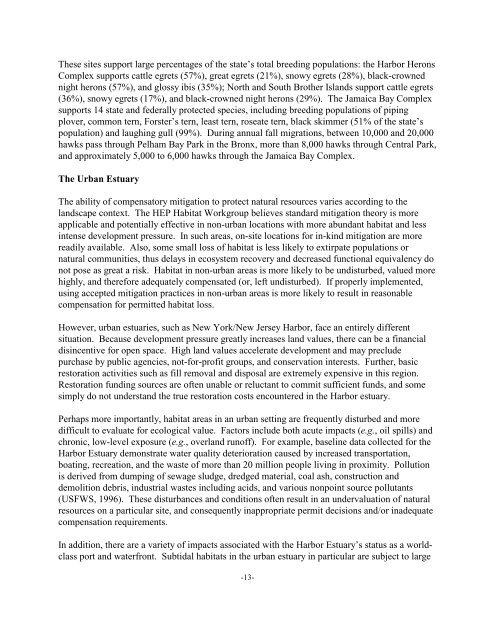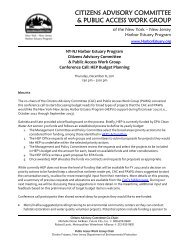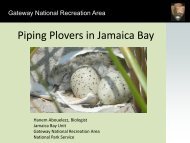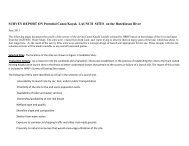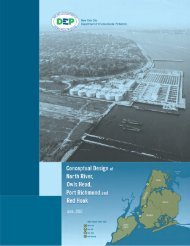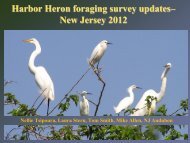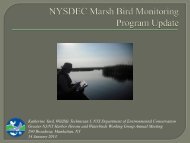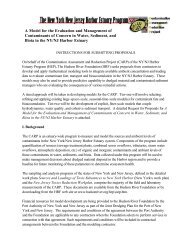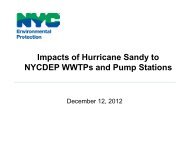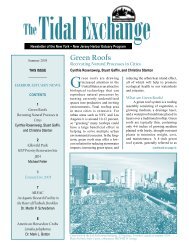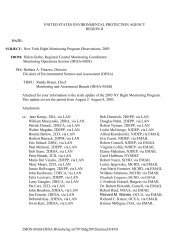DraftMitigation .pdf - New York-New Jersey Harbor Estuary Program
DraftMitigation .pdf - New York-New Jersey Harbor Estuary Program
DraftMitigation .pdf - New York-New Jersey Harbor Estuary Program
Create successful ePaper yourself
Turn your PDF publications into a flip-book with our unique Google optimized e-Paper software.
These sites support large percentages of the state’s total breeding populations: the <strong>Harbor</strong> Herons<br />
Complex supports cattle egrets (57%), great egrets (21%), snowy egrets (28%), black-crowned<br />
night herons (57%), and glossy ibis (35%); North and South Brother Islands support cattle egrets<br />
(36%), snowy egrets (17%), and black-crowned night herons (29%). The Jamaica Bay Complex<br />
supports 14 state and federally protected species, including breeding populations of piping<br />
plover, common tern, Forster’s tern, least tern, roseate tern, black skimmer (51% of the state’s<br />
population) and laughing gull (99%). During annual fall migrations, between 10,000 and 20,000<br />
hawks pass through Pelham Bay Park in the Bronx, more than 8,000 hawks through Central Park,<br />
and approximately 5,000 to 6,000 hawks through the Jamaica Bay Complex.<br />
The Urban <strong>Estuary</strong><br />
The ability of compensatory mitigation to protect natural resources varies according to the<br />
landscape context. The HEP Habitat Workgroup believes standard mitigation theory is more<br />
applicable and potentially effective in non-urban locations with more abundant habitat and less<br />
intense development pressure. In such areas, on-site locations for in-kind mitigation are more<br />
readily available. Also, some small loss of habitat is less likely to extirpate populations or<br />
natural communities, thus delays in ecosystem recovery and decreased functional equivalency do<br />
not pose as great a risk. Habitat in non-urban areas is more likely to be undisturbed, valued more<br />
highly, and therefore adequately compensated (or, left undisturbed). If properly implemented,<br />
using accepted mitigation practices in non-urban areas is more likely to result in reasonable<br />
compensation for permitted habitat loss.<br />
However, urban estuaries, such as <strong>New</strong> <strong>York</strong>/<strong>New</strong> <strong>Jersey</strong> <strong>Harbor</strong>, face an entirely different<br />
situation. Because development pressure greatly increases land values, there can be a financial<br />
disincentive for open space. High land values accelerate development and may preclude<br />
purchase by public agencies, not-for-profit groups, and conservation interests. Further, basic<br />
restoration activities such as fill removal and disposal are extremely expensive in this region.<br />
Restoration funding sources are often unable or reluctant to commit sufficient funds, and some<br />
simply do not understand the true restoration costs encountered in the <strong>Harbor</strong> estuary.<br />
Perhaps more importantly, habitat areas in an urban setting are frequently disturbed and more<br />
difficult to evaluate for ecological value. Factors include both acute impacts (e.g., oil spills) and<br />
chronic, low-level exposure (e.g., overland runoff). For example, baseline data collected for the<br />
<strong>Harbor</strong> <strong>Estuary</strong> demonstrate water quality deterioration caused by increased transportation,<br />
boating, recreation, and the waste of more than 20 million people living in proximity. Pollution<br />
is derived from dumping of sewage sludge, dredged material, coal ash, construction and<br />
demolition debris, industrial wastes including acids, and various nonpoint source pollutants<br />
(USFWS, 1996). These disturbances and conditions often result in an undervaluation of natural<br />
resources on a particular site, and consequently inappropriate permit decisions and/or inadequate<br />
compensation requirements.<br />
In addition, there are a variety of impacts associated with the <strong>Harbor</strong> <strong>Estuary</strong>’s status as a worldclass<br />
port and waterfront. Subtidal habitats in the urban estuary in particular are subject to large<br />
-13-


